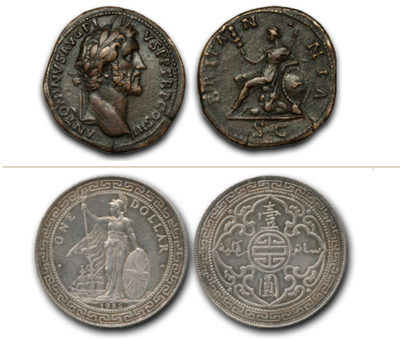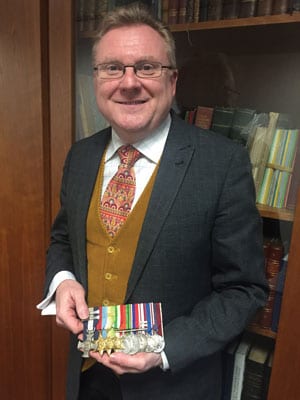A Brief History of the Gold Sovereign
There are many sources for the history of the gold Sovereign some of which are given in the Bibliography but one of the more recent, succinct and accurate is that which this cataloguer would recommend in the Royal Mint publication “The Gold Sovereign 1489-1989” essay The Fifteenth Century Revival” by John Pourteous, published 1989.
Introduced by King Henry VII (1485-1509), in 1489 the gold Sovereign in the hand made hammered period of our Tudor Coinage formed the grandest and most impressive coin ever issued in the English series at that date. This was a direct result of the influence of the Renaissance style that had emanated from Italy and a distinct display at how wealthy King Henry VII had become after the closure of the 100 years war and his own victory over King Richard III (1483-5) at the Battle of Bosworth Field.
The gold Sovereign issued at 30 Shillings and struck in 23 carat 3 7/8 grains fine gold, was approximately 38mm in diameter and weighing some 30g was a most impressive issue. It was a most illustrious coin depicting the King seated on his throne with orb and sceptre, surrounded by a tressure of many arcs and a legend declaring him King of England, France and Lord of Ireland. The reverse showing a full bloom Tudor rose, it is a most impressive coin and went through five incarnations in Henry VII’s reign alone, which is a great deal for a denomination that was not used in everyday transactions and never really seen by the majority of the population.
A Tudor centrepiece, the Sovereign continued to be issued in fine gold into the reign of Henry VIII (1509-47) through three incarnations, but due to the extravagant spending of the King, the coinage suffered and subsequent issues of the gold Sovereign endured being reduced in weight, and eventually in fineness to as low as 20 carats. It was only through the efforts of his son, the “boy” King Edward VI (1547-53), that the fineness of the gold Sovereign was eventually restored and a 30 Shilling face value, running through three different issues of Sovereign in his short reign.
Edward’s older sister Queen Mary (1553-8), continued the issue of the fine gold Sovereign in her reign as did her younger sister Queen Elizabeth I (1558-1603), though Elizabeth also introduced a lower 22 carat 20 Shilling gold piece the Pound which ran concurrently and then solely to the end of her reign. During the reign of Queen Elizabeth the first experimentation began with striking by method of machine, which was too controversial to be introduced over the traditional hammered method at this time circa 1561-70.
The Stuart King James I (1603-25), already King of Scotland since 1567, issued a fine gold Sovereign for the first two years of his reign of a different design to Elizabeth. However from 1605 James demonstrated how he was King of both England and Scotland by introducing a new 20 Shilling denomination the “Unite” and latterly in his final coinage the “Laurel” where he is depicted laureate and draped like a Roman Emperor. The 30 Shilling Sovereign had become the Rose Ryal in this coinage and latterly the Spur Ryal of differing designs, two types of which depict the King quite life-like seated on the throne as with the Tudor Sovereigns.
The Unite denomination was continued as the staple gold coin into the reign of his son King Charles I (1625-49). During the Civil War the gold coins were issued provincially for the first time and we see the issue of the largest hammered gold denomination ever, the magnificent Triple Unite from both Shrewsbury and Oxford.
The Puritans under Oliver Cromwell continued the issue of the Unite through the guise of the Commonwealth (1649-60), though by now the concept of machinery was being entertained in the Mint once again and there was a Pattern milled “Broad” of 20 Shillings produced bearing the portrait of Oliver Cromwell in 1656.
At the Restoration King Charles II (1660-85) expressed his wish for mechanisation of the Mint, however the controversial machinery based at Drury House on The Strand, London where it had been housed through fear of sabotage from the hammered workers, was so massive that it took nigh on two years to fully move all the parts across, and set them up in the Tower of London within the Mint compound. During this delay Charles II issued at first his own hammered gold Unite of 20 Shillings, later termed a “Broad” once the milled machine-made coinage emerged from 1663 as the diameter of the hammered piece was larger though much thinner than its machine made counterpart.
This machine made piece was the gold Guinea and was first coined in 1663 initially at 20 Shillings face value. Officially it was a Twenty Shilling piece, but colloquially called a Guinea, so-named after the place where most of the gold supply came from being Guinea in Africa. Some gold supplied by the “African Company” was denoted with either an elephant, or elephant and castle, below the busts.
This successful denomination continued through the reigns of all the other Stuart Monarchs, King James II (1685-88), William and Mary (1688-94), King William III (1694-1702), Queen Anne (1702-14), some issues with the African mark, and in Queen Anne’s reign a very rare issue with VIGO below the bust denoting gold captured from the Spanish after the Vigo Bay conflict. Throughout all of these reigns including those back in the hammered Tudor and Stuart period, the price of gold had fluctuated as the gold to silver ratio varied over time compared with those ratios in trade in Europe, and at various times the supply of gold or silver coin maybe flowing into or out of England, hence varying the face value of the gold Guinea. This coupled with the poor state of the silver coinage before the Great Recoinage of silver in 1696, meant the value of the “Guinea” fluctuated as high as 30 Shillings.
The Master of the Mint in the reign of Queen Anne was a certain Mr Isaac Newton (later knighted), who recognised the problem of a lack of fixed face value on the gold and it was in a Proclamation of 1717 in the succeeding reign that the value was set at 21 Shillings for a Guinea with which we are still familiar today in traditions like the 10,000 Guineas horse race. This set the mark for the 100 year period until the introduction of the modern gold Sovereign.
The Guinea continued to be issued by the Hanoverian dynasty, from King George I (1714-27), King George II (1727-60), and King George III (1760-1820). During the reign of King George II, in 1733 all the old hammered gold was finally called in to be withdrawn, the silver having already been withdrawn back in the reign of William III and the Great Recoinage .
However there was still a long-standing issue with the import and export of silver and gold coin and the lack of harmonisation in Europe of the gold and silver ratio. Towards the end of the 18th Century there had become a distinct lack of small change in silver, as there was no limit to the specie of how coin and bullion payments were made up in transactions, both here and overseas. This major problem was relieved in part by the Bank of England who released their stocks of silver Spanish Colonial dollars to be countermarked with a head of King George III and circulate, however these countermarked Dollars were unfortunately easily copied. This problem was solved in the short term by Matthew Boulton of the Soho Mint, who used James Watt’s steam presses to totally overstrike the Spanish Dollars with a Bank of England design. However the lack of a law of legal tender still meant that large payments could be tendered in large quantity of silver, and it was subsequently drained out of England and onto the Continent.
After much deliberation in Parliament this led to the Coinage Act of 1816, in which the involvement of Lord Liverpool was instrumental, where a limit of 40 shillings was set upon payments made in silver, with gold remaining legal tender for payments of any size. This immediately helped the flow and ratio of gold and silver, and made the use of European and foreign coin illegal. A newly anticipated “recoinage” was in preparation and underway with gestation and proposals starting in 1816. The Chief Engraver who later died that year was Thomas Wyon Jnr. who submitted designs as well as the Italian Second Engraver Benedetto Pistrucci. The Master of the Mint was William Wellesley Pole, later Lord Maryborough, brother of the Duke of Wellington was instrumental in bringing Pistrucci to the Mint and whose work was eventually adopted for the new coinage.
The modern gold Sovereign was first issued on 5th July 1817 at a weight of 7.98grammes and 22mm in diameter with a face value of One Pound or Twenty Shillings. The gold Half-Sovereign followed later in the year in October.
























